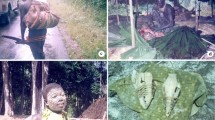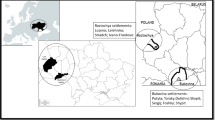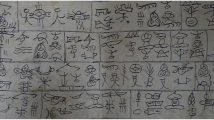Abstract
Material culture of the aboriginal tribes of Andaman and Nicobar Islands is quite delightful as much of the work remains uncovered till date. Preservation and protection of utilitarian knowledge of various tribes is quite essential as it significantly contributes towards developing important strategies by identifying cost effective and sustainable mechanisms. Utilitarian knowledge is an empirical or experiential aptitude developed by a tribe which is passed on from one generation to other and is constantly evolving in response to the changing environment. Artefacts are man-made objects of prehistoric origin. Study of tribal artefacts is being sidelined as preference is being given to edible and medicinal plants. Shompens are semi-nomadic food gatherers and hunters of stone-age civilization inhabiting deep forests of Great Nicobar Island (GNI). Shompen tribe is one of the dwindling mongoloid aborigines and presently it is an ethnic oddity. They are entirely dependent on forest resources and sea products for all their needs. Shompens appear to be an intermediate group between the Andamenese and Nicobarese, as they combine their food gathering and hunting habits with some gardening and herding. Accordingly, the material culture exhibiting their utilitarian habits presents unique scenario. Ethnobotanical studies conducted among the shompens inhabiting Jhaunala, Laful, Shompenhut, East West Road and Kopenheat areas of GNI have revealed interesting information about 43 plants pertaining to artefacts used in shelter, transportation, hunting, fishing, food gathering, ornamentation, cooking vessel, fire drill and dressing purposes. This research article also presents a glimpse of such artefacts developed using forest resources, highlighting their ethnoecological and cultural influences besides tracing out the economic utility of native plant species traditionally employed by the rare and ethnic Shompen tribe of GNI. Further, it provides the baseline data for drawing a road map for critical scientific evaluation of plants and plant products for developing value added products thereby boosting the economy of the region.




Similar content being viewed by others
References
Ahamed SKZ, Ravikumar T, Krishnan P, Jeyakumar S (2013) Traditional fishing Crafts and gears used by the Nicobari tribes in Car Nicobar. Indian J Tradit Knowl 12(1):144–148
Balakrishnan NP, Hore DK, Dwivedi RP (1984) Status survey of the floral constituents in the Island ecosystem of Great Nicobar Island in the present context of changing habitats. A man and biosphere project report, 1979–82, Botanical Survey of India, Howrah, p 319
Benjamin TW, Carolyn OM, Laurie M, Gary PN (2016) The importance of indigenous knowledge in curbing the loss of language and biodiversity. Biosciences 66(6):499–509
Bhargava N (1981) Plants in folklife and folklore in Andaman and Nicobar Islands. In: Jain SK (ed) Glimpses of Indian ethnobotany. Oxford & IBH, New Delhi, pp 329–344
Boden KC (1902) Andamans and Nicobars, rep. edition 1971. Vivek Publishing House, New Delhi
Bruchac M (2014) Indigenous knowledge and traditional knowledge. In: Smith C (ed) Encyclopedia of global archaeology. Springer, New York, pp 3814–3824
Chakraborty T, Balakrishnan NP (2003) Ethnobotany of the Andaman and Nicobar Islands, India—a review. J Econ Taxon Bot 27:869–893
Chakraborty T, Rao MKV (1988) Ethnobotanical studies on the Shompens of the Great Nicobar Island. J Econ Taxon Bot 12:39–54
Chib SS (1985) Andaman, Nicobar and Lakshadweep Islands, vol 9. Ess Ess Publishers, New Delhi
Dagar JC, Singh NT (1999) Plant resources of the Andaman and Nicobar Islands. Bishen Singh Mahendra Pal Singh, Dehra Dun, pp 32–48
Das HH, Rath R (1989) The land of the coral beds: Andaman & Nicobar Islands. Aruna Printing Works, Orissa, pp 43–45
Gamble JS, Fischer CEC (1959) The flora of the Presidency of Madras, rep. edition, vol I–III. Botanical Survey of India, Calcutta
Hajra PK, Rao PSN (1999) Flora of Great Nicobar Island. Botanical Survey of India, Kolkata
Justin A (2016) The Shompen of Andaman and Nicobar Islands. In: Misra KK (ed) The particularly Vulnerable Tribal Groups in India. Manohar Publishers & Distributors, Daryaganj, pp 669–679
Newmaster SG, Subramanyam R, Ivanoff RF, Balasubramaniam NC (2006) Mechanism of the ethnobiological classifications. Ethnobotany 18:4–26
Oberai CP (2000) Ecotourism paradise-Andaman and Nicobar Islands. BR Publishing Corporation, Delhi, p 179
Pandit TN (1972) Tribes of Andaman and Nicobar Islands. In: Suresh Singh K (ed) The Tribal situation in India. Motilal Banarsidass, Delhi, pp 239–259
Pankaj S (2003) Troubled Islands. Mudra, 383 Narayan Peth, Pune
Parkinson CE (1923) A forest flora of the Andaman Islands. Bishen Singh Mahendra Pal Singh, Dehra Dun
Rizvi SNH (1990) The Shompen—a vanishing tribe of the Great Nicobar Island. Seagull Books, Calcutta
Sharief MU (2008) Tribal artifacts of Nicobari folk of Nicobar Archipelago. Indian J Tradit Knowl 7(1):42–49
Sharief MU, Panda SP (2018) Material Culture of the ethnic aboriginal Jarawa folk in Andaman Islands, India. Gen Res Crop Evol 65(5):1369–1384
Sharief MU, Rao RR (2007) Ethnobotanical studies of Shompens—a critically endangered and degenerating ethnic Community in Great Nicobar Island. Curr Sci 93(11):1623–1628
Sreekumar PV (1997) Are we losing our Heritage. Curr Sci 72:541–543
Tripathi SK (2003) Traditional knowledge: its significance and implications. Indian J Tradit Knowl 2(2):99–101
Acknowledgements
The authors are thankful to Dr. A.A. Mao the Director, Botanical Survey of India, Kolkata for granting necessary permission, guidance and encouragement. Authors are also grateful to the Head of Office, BSI, A&N Regional Centre, Port Blair and the Director, Tribal Welfare, A&N Administration, Port Blair for overall help and facilities. Thanks are also due to all the members of the Shompen Tribe who in one or other way helped and shared their experiences pertaining to utilitarian knowledge. The assistance rendered by Sri V. Ramesh, for preparation of photographic plates is gratefully acknowledged.
Funding
The present research work has been carried out as part of Approved Annual Action Plan program of Ministry of Environment, Forest and Climate Change, New Delhi with recurring sanctioned budget of Botanical Survey of India and does not involve any funding from other external agencies/departments.
Author information
Authors and Affiliations
Corresponding author
Ethics declarations
Conflict of interest
The authors declare that they have no conflict of interest.
Human and animal rights
In the present research work no humans/animals has been harmed or injured. The ethno botanical data collection was done with prior consent and permission obtained from Tribal Welfare Directorate, Port Blair and persons concerned.
Additional information
Publisher's Note
Springer Nature remains neutral with regard to jurisdictional claims in published maps and institutional affiliations.
Rights and permissions
About this article
Cite this article
Sharief, M.U., Panda, S.P. Folklore artefacts of aboriginal Shompen tribe in Great Nicobar Island, India. Genet Resour Crop Evol 68, 835–847 (2021). https://doi.org/10.1007/s10722-020-01027-x
Received:
Accepted:
Published:
Issue Date:
DOI: https://doi.org/10.1007/s10722-020-01027-x




